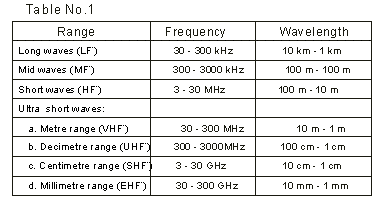2.3. Wavebands
While considering problems related to the realization of the long - distance radio links, significant differences between the electromagnetic waves of various frequencies must be kept in mind. For example, low frequency waves (below 500 kHz) can bend themselves following Earth's curvature, while the HF waves are moving in streamlines, just as light. Some waves can be reverberated from the ionosphere, others are passing through it etc. According to characteristics of their outspread, radio waves can be classified into several groups or ranges: long, mid, short and ultra-short. Limits between the wavebands are not precise, with the raise of their frequency the waves are gradually losing some features while gaining some others. This division is shown in Table 1.

* LF low frequencies, MF mid frequencies, HF high frequencies, VHF very high frequencies, UHF ultra high frequencies, SHF super high frequencies, EHF extra high frequencies. Waves with wavelength smaller than 30 cm are also called the microwaves.
In the third table column the wavelengths are given. Wavelength (ë) is distance that the wave passes moving at the speed of light (c=3*103 m/s), during the period that is equal to its oscillating period (T): ë=c*T. Having in mind that the wave frequency is f=1/T, one can easily get to the well known expression that gives the relation between the wavelength and the frequency:

Using this formula one can calculate the wavelength knowing the frequency and vice versa. For example, wavelength of an FM transmitter emitting at f=100 MHz frequency is L=3*108/100*106=3 m. Similar to that, wavelength of Radio Belgrade 1 is L=439 m, which makes its frequency equal to f=3*108/439=684 kHz.
Radio diffusion is being performed in certain parts of the wavebands given in Table 1, their boundary frequencies are (rounded values):
LW (long waves) 150 kHz (2km) 300 kHz (1 km)
MW (mid waves) 500 kHz (600 m) 1500 kHz (200 m)
SW (short waves) 6 MHz (50 m) 20 MHz (15 m)
FM (ultra short waves) 88 MHz (3.4 m) 108 MHz (2.78 m)
In LW, MW and SW the amplitude modulation is used, while in FM range it is the frequency modulation.
Here are the frequencies (in kHz) of some radio transmitters from the MW range, that can serve for tuning of the radio receivers being described in this issue: Timisoara 630, Belgrade1 684, Bucharest 855 .


![]()